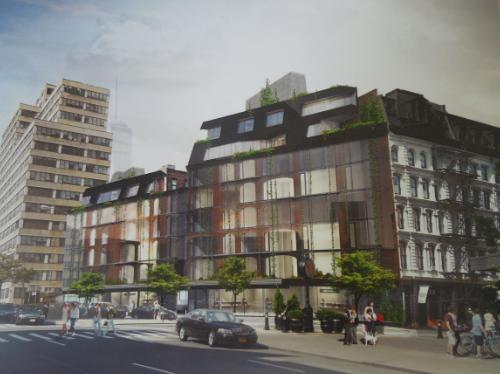
Rendering of proposed development on 100 Franklin Street in Tribeca, Manhattan. Image Credit: DDG Partners. Image Courtesy of the Historic Districts Council.
Plan would see the construction of two connected mixed-use buildings on triangular-shaped lots, currently used for parking, on Sixth Avenue extension. On November 12, 2013, the Landmarks Preservation Commission held a hearing on the proposal for two adjacent irregularly shaped lots on 100 Franklin Street in the TriBeCa East Historic District. DDG Partners is seeking to develop the property with two conjoined structures that would include ground-floor retail and residential use on the upper floors. Representing DDG, Valerie Campbell, attorney at Kramer Levin, stated that the triangular lots had been vacant since the extension of Sixth Avenue in 1930. Campbell also stated that because of the site’s unique characteristics, which includes a below-grade subway tunnel directly in front of the property lot line, the project would likely require variances from the Board of Standards and Appeals for lot coverage, street wall, and set back requirements.
DDG architect Peter Guthrie presented the plan and design for the site, which was influenced by the 19th-century store-and-loft architecture of the district. Guthrie said the plan would “repair the scar” in the street wall created by the Sixth Avenue extension. Although the site’s C6-2A zoning would allow buildings up to 120 feet tall, the project would only rise to 76 feet on the south and 100 feet to the north. He said the building would be organized similarly to the historic structures of the neighborhood, with a classical tripartite arrangement of a base, middle, and top.
The recessed ground floor facade would be faced in glass, creating an “inset floating base,” with a projecting planter above the storefront to increase its perception of depth. Guthrie noted that cast-iron architecture would include expanses of glass that had previously been impossible. The middle sections would include “a palimpsest of layers” with a facade of reclaimed brick and arched windows behind a glass rain screen. The “undulating roofscape,” inspired by mansard roofs, would be composed of dark grey glass panels reminiscent of historic slate roofs in a contemporary material. Bulkheads on the roof would be set back from the street wall, but would be visible from public thoroughfares. Guthrie said DDG was also working with the MTA on the possibility of installing a granite sidewalk and street trees.
A representative of local Assembly Member Deborah Glick spoke in opposition to the proposal, stating she was “extremely concerned about the height and bulk of the building” and the project’s “overwhelming amount of glass.” Lynn Ellsworth of the Tribeca Trust testified that the proposal “defies any normal sense of contextual development.” One resident likened the proposal to something that belonged in “a shopping mall on New Jersey’s Route 3” that was in no way appropriate to the historic district. Some speakers said the site should be kept as open space or converted to green space, and that any development on the site would be harmful to the district. Others expressed concern about the project’s impact on the ornate historic building directly to the north at 17 White Street. The Historic Districts Council is also in opposition to the proposal.
A representative of Manhattan Community Board 1 said that although the Landmarks Committee initially voted to recommend approval of the project, the committee opposed the design of the roof. He noted that community members were not well informed of the proposal. The full Community Board did not adopt the recommendation, and requested that Landmarks hold over the proceeding so that the community could work with the applicants to revise the project. He asked Landmarks to keep the record open so that the Board could submit a recommendation, and to reject the roof and bulkheads if it proceeded to a vote.
Carol Conway of the 35 Bond Street Corporation praised DDG’s development at 41 Bond Street, and spoke highly of their cooperation with their neighbors and engagement with the community.
Commissioner Fred Bland said that the site was an appropriate location for new buildings, but the proposal was not acceptable as presented. He stated that the design was “frantic” and needed to be “calmed down” to serve as a placeholder, rather than a distraction, in the district. He also stated that the glass panels were not an appropriate material for the roof, and the northern portion should be reduced in height by one story. Commissioner Michael Goldblum found the scale generally appropriate, but agreed that the design was “muddled.” Goldblum said that the salvaged brick behind a layer of glass was not a successful scheme, and that there should be more interaction between the brick and the glass. Commissioner Joan Gerner found the rooftop bulkheads excessively high and dense, and also found the all-glass storefront inappropriate. Commissioner Libby Ryan concurred that the bulkheads and roof configuration required another study.
Chair Robert B. Tierney asked the applicants to revise the project in light of commissioner comments and return to Landmarks at a later date. Tierney stated that the record would be kept open for two weeks so that the Community Board could submit a resolution on the project.
LPC: 100 Franklin Street, Manhattan (14-9035) (Nov. 12, 2013) (Architect: DDG Partners).
By: Jesse Denno (Jesse is a full-time staff writer at the Center for NYC Law)

